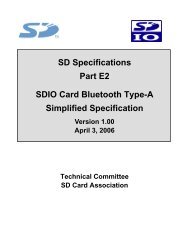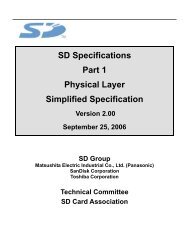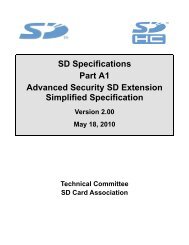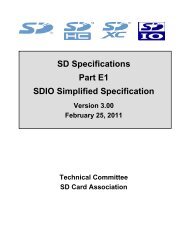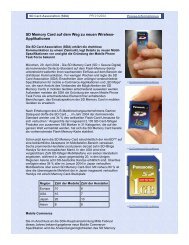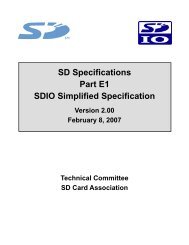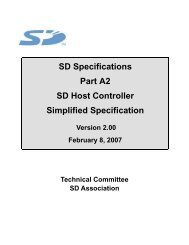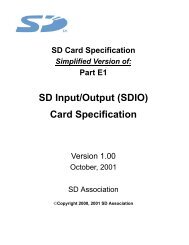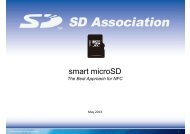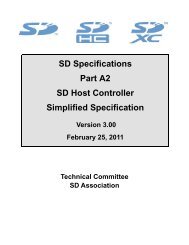SD Specifications Part 1 UHS-II Simplified Addendum - SD Association
SD Specifications Part 1 UHS-II Simplified Addendum - SD Association
SD Specifications Part 1 UHS-II Simplified Addendum - SD Association
Create successful ePaper yourself
Turn your PDF publications into a flip-book with our unique Google optimized e-Paper software.
<strong>UHS</strong>-<strong>II</strong> <strong>Simplified</strong> <strong>Addendum</strong> Version 1.01©Copyright 2010-2013 <strong>SD</strong> Card <strong>Association</strong> Device never returns ready in illegal ACMD41, and the state transits to 'idle' state. CMD11 shall be skipped. Related to this Device shall set '0' to S18A field in RES of ACMD41. If Device receives CMD3, Device responds with its own Node ID as new RCA. As each Device'sNode ID is guaranteed to be distinctive even in case of multiple-Device connection, Host does notneed to reissue CMD3 for avoiding RCA duplication. The 'ina' state and its related transition are removed from <strong>SD</strong>-TRAN.During card identification mode, Device operation when receiving native CMD is same as that in Activestate. Host cannot issue arbitrary DCMD during this mode. Note that card status is kept when receivingGO_DORMANT_STATE CCMD. So Device directly transits to the appropriate card status after <strong>UHS</strong>-<strong>II</strong>Initialization in case of recovery from Dormant state. For example, if card status was 'ready' beforetransiting to Dormant state, it is still 'ready' after recovering from Dormant state. This rule is same as for'idle' and 'ident' (and also same as 'stby' and 'tran' in Data Transfer Mode).7.2.4.2 Data Transfer ModeFigure 7-15 shows a state diagram for data transfer mode of <strong>SD</strong>-TRAN. Differences from the Legacy<strong>SD</strong> are as follows. Common CMDs with Legacy <strong>SD</strong> shall be executed through <strong>SD</strong>-TRAN. The 'dis' state and its related transitions are abandoned for simplicity. And transition from 'data'state to 'stby' state is also removed. Transitions by CMD7 are defined as follows. Transits to 'tran' if RCA in CMD7 is equal to Device's Node ID. Transits to 'stby' if RCA in CMD7 is not equal to Device's Node ID. RCA in the argument shall be ignored other than CMD7. If Device receives illegal command in 'stby' state, Device shall return RES with NACK = 1. CMD13 can be issued only in 'stby' or 'tran' state. In other words, CMD13 cannot be issued duringCTS in case of <strong>SD</strong> memory. When Device receives CMD3 in 'ident' state or 'stby' state, Device shall always return its Device IDas RCA.For read transaction, state transits from 'data' to 'tran' at transmission of MSG (EBSY). For writetransaction, state transits from 'rcv' to 'prg' when Device receives all DATA packets specified by TLENon write DCMD, or it transmits RES (R1b) of CMD12 corresponding to write DCMD. In addition, statetransits from 'prg' to 'tran' at transmission of MSG (EBSY).87



